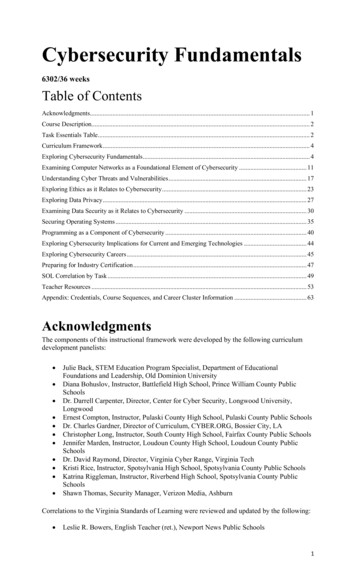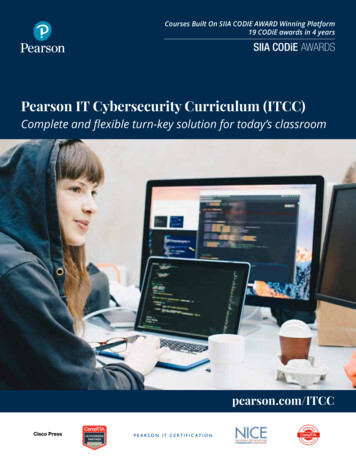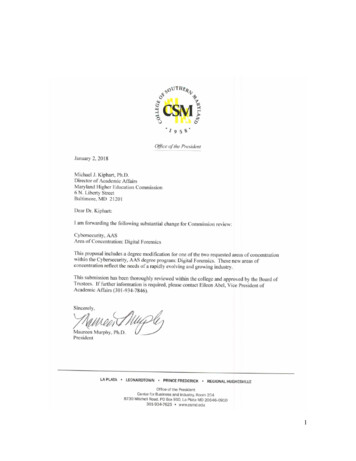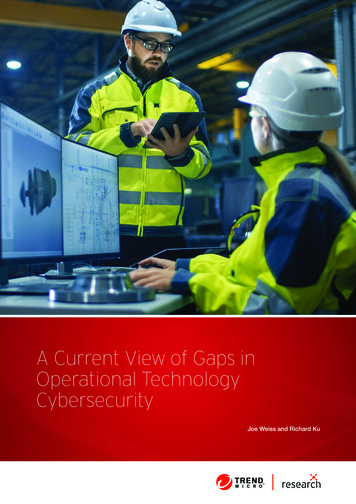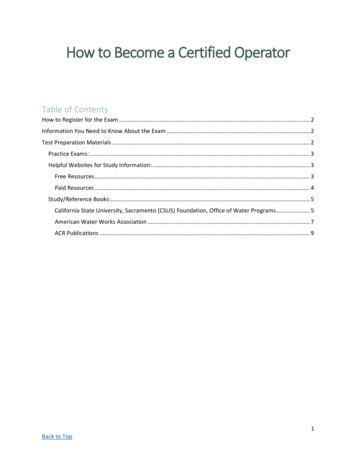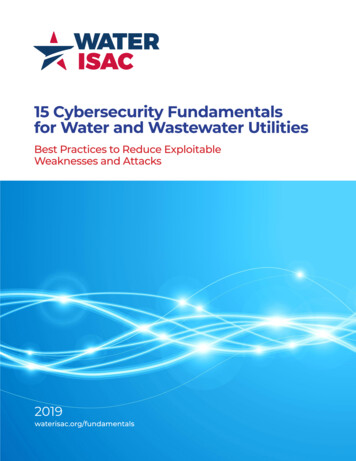
Transcription
1
15 Cybersecurity Fundamentals for Water andWastewater Utilities 2019 WaterISACWater Information Sharing and Analysis Center (WaterISAC)1620 I Street, NW, Suite 500Washington, DC c.org
About WaterISACThe mission of the Water Information Sharing and Analysis Center, better known as WaterISAC,is to enhance the security of water and wastewater utilities by providing information and toolsfor preventing, detecting, responding to, and recovering from all hazards.WaterISAC is a non-profit organization created in 2002 by and for the water and wastewatersector. It is governed by a board of managers comprising water and wastewater utilitymanagers and a state drinking water agency administrator who are appointed by the AmericanWater Works Association, the Association of Metropolitan Water Agencies, the Association ofState Drinking Water Administrators, the National Association of Clean Water Agencies, theNational Association of Water Companies, the National Rural Water Association, the WaterEnvironment Association and the Water Research Foundation.Member organizations include drinking water and wastewater utilities, local, state and federalgovernment agencies, industry organizations and private firms that support water andwastewater utilities.WaterISAC is the only all-threats security information source for the water and wastewatersector. It is the most comprehensive and targeted single point source for data, facts andanalysis on water security and threats. WaterISAC also provides analysis and resources tosupport response, mitigation and resilience initiatives.WaterISAC delivers timely, actionable information you can put to use right away toSupercharge Your Security.Learn more and join WaterISAC at waterisac.org/membership.For more information about WaterISAC, contact:Michael ArceneauxManaging Director202-331-0479arceneaux@waterisac.org
PrefaceThe original version of this guide, “10 Basic Cybersecurity Measures to Reduce ExploitableWeaknesses and Attacks,” appeared in 2012 and was updated in 2014 and 2016. This newversion has been significantly reorganized and revamped and it contains the latest information.Therefore, the guide has the new name it appears with today.The guide is intended to provide an overview of cybersecurity measures, not to be an exhaustiveresource or a step-by-step guide. Hyperlinked resources produced by government and privatesources accompany each measure for deeper exploration.
AcknowledgementsWaterISAC thanks Jennifer Lyn Walker, WaterISAC cybersecurity risk analyst, for leading thedevelopment of this guide. WaterISAC also gives special thanks to Andrew Hildick-Smith of theMassachusetts Water Resources Authority for his advice and his very substantial contributionsto the guide’s content.WaterISAC also thanks its members, whose dues made this guide possible.
Table of ContentsIntroduction . 1Report Incidents and Suspicious Activity to WaterISAC and Authorities . 31. Perform Asset Inventories . 72. Assess Risks . 93. Minimize Control System Exposure . 114. Enforce User Access Controls . 155. Safeguard from Unauthorized Physical Access . 196. Install Independent Cyber-Physical Safety Systems . 217. Embrace Vulnerability Management . 238. Create a Cybersecurity Culture . 259. Develop and Enforce Cybersecurity Policies and Procedures (Governance) . 2910. Implement Threat Detection and Monitoring . 3111. Plan for Incidents, Emergencies and Disasters . 3512. Tackle Insider Threats . 3913. Secure the Supply Chain . 4114. Address All Smart Devices (IoT, IIoT, Mobile, etc.) . 4315. Participate in Information Sharing and Collaboration Communities . 47
IntroductionWater and wastewater utilities provide critical lifeline services to their communities and theirregions. Safe water and clean water are essential for public health, ecosystem protection andeconomic strength. Supporting these important functions requires secure informationtechnology (IT) and operational technology (OT).Yet, our sector’s IT and OT networks continue to face an onslaught of threats from cybercriminals and nation-states, hacktivists and others. Cyber criminals’ attacks, both indiscriminateand targeted, are designed to steal or extract money and collect sensitive personal information,which in turn can be sold to the highest bidder. Nation-states – primarily Russia, China, NorthKorea and Iran – have demonstrated the desire and ability to infiltrate IT and OT systems and,in the case of the energy and manufacturing sectors in other countries, to disrupt operations.“Moscow is now staging cyberattack assets to allow it to disrupt or damage U.S. civilian andmilitary infrastructure during a crisis, and poses a significant cyber influence threat,” says DanCoats, Director of National Intelligence.IT and OT compromises can have great impact on a utility. These include the loss of staffproductivity and the cost of rectifying an IT or OT compromise, as well as reputational damagethat can result from allowing the theft of customer data. Worse, potential operationaldisruptions could jeopardize public health and environmental protection.Although many water and wastewater utilities have invested the necessary time and resourcesin cybersecurity, more progress is necessary on the part of the sector to secure IT and OTsystems. This guide is intended to show a path toward that goal.The guide will also be helpful to utilities preparing risk and resilience assessments required byAmerica’s Water Infrastructure Act, or AWIA. The 15 fundamentals discussed here will also beespecially useful for informing emergency response plans because AWIA requires those plans toaddress mitigation and resilience options.John P. Sullivan, PE, BCEEChairmanDiane VanDe HeiExecutive Director15 Cybersecurity Fundamentalsfor Water and Wastewater Utilities1
15 Cybersecurity Fundamentalsfor Water and Wastewater Utilities2
Report Incidents and Suspicious Activity to WaterISAC and Authorities“It takes a community to protect a community.” That is the underlying theme of theDepartment of Homeland Security’s “If You See Something, Say Something” program. It is alsothe foundation of information sharing and it is what motivates WaterISAC‘s mission to helpprotect the security of our members and the water and wastewater sector at large.WaterISAC urges utilities and others sector stakeholders to report incidents and suspiciousactivity to our analysts. Reporting incidents and suspicious activity helps strengthen sectorresilience, because it allows WaterISAC to identify threats and vulnerabilities and to warn othermembers and partners. The information you share also helps WaterISAC shape products andservices, including webinars and reports, that can help utilities stay safe and secure.WaterISAC maintains confidentiality of the information provided by submitters. If WaterISACwishes to share your incident in an analysis or other product, we would first secure yourexpress permission to do so, then would anonymize the information you have shared. As aprivate non-profit, WaterISAC is not subject to public records law, further preserving thesecurity of your report.In some cases it may necessary or preferable to also report your incident or suspected incidentto federal authorities, especially if you intend to seek help with an investigation or recovery.Crimes should always be reported to the appropriate authorities.How do I make a report?You can file reports of incidents and suspicious activity in three ways:1. By filing a confidential report at www.waterisac.org/report -incident.2. By emailing analyst@waterisac.org.3. By calling our analyst desk at 866-H2O-ISAC.What do I report?WaterISAC seeks reports of both cyber and physical incidents, as well as suspicious activity.Cybersecurity IncidentsCybersecurity incidents are cyber attacks or compromises of your enterprise IT system or yourindustrial control system. These events could be: Successful ransomware attacks or close calls.Successful installations of malware that had or may have had an impact on the utility’sability to conduct business and operations.Phishing campaigns, including successful or attempted spear phishing of executives,executive assistants, SCADA engineers, IT administrators or other privileged users.15 Cybersecurity Fundamentalsfor Water and Wastewater Utilities3
Successful or attempted business email compromise incidents, including accounttakeover or impersonation of executives.Data thefts.Social engineering attempts to gather sensitive information from personnel.Physical Security IncidentsReportable physical security incidents include those that are intended to cause any of thefollowing: Bodily harm to employees or customers.Public health impacts.Significant harm to the environment.Impacts to the operations of your utility.Financial losses to your organization of 10,000 or more (per instance.)Specific examples of these types of incidents include: Intentional water supply or wastewater veillance or suspicious questioning.Threats.What happens next?Once you alert us to the incident or suspicious activity, we will follow up with you for moreinformation. Then we will ask whether we can use the information in WaterISAC reports. If theanswer is yes, we will anonymize the information you shared by removing any details thatwould attribute the incident to you or your utility. The information you share is stored in aprotected database. The anonymized information will be used to inform WaterISAC's “ThreatAnalysis Report,” which is produced twice each year for members, and perhaps other reports.Federal and Other Reporting MechanismsUnited StatesDepartment of Homeland Security National Cybersecurity and Communications IntegrationCenter (NCCIC). Report incidents to NCCIC by emailing NCCICCUSTOMERSERVICE@hq.dhs.govor by calling 888-282-0870. You may also contact WaterISAC for an introduction to NCCIC staff.DHS can protect sensitive information that is shared with its teams, if requested.15 Cybersecurity Fundamentalsfor Water and Wastewater Utilities4
NCCIC’s Hunt and Incident Response Team provides onsite incident response free of charge toorganizations that require immediate investigation and resolution of cyber compromises.Federal Bureau of Investigation (FBI). The FBI encourages victims of internet crimes to contactan FBI field office. Crime complaints can also be made to the bureau’s Internet Crime ComplaintCenter (IC3) at www.ic3.gov.MS-ISAC and E-ISAC. Members of the Multi-State ISAC and the Electricity ISAC should reportincidents through established channels.Fusion Centers. State Fusion Centers are another possible reporting option. Fusion centers areeffective at appropriately sharing information and have strong relationships with DHS and otherorganizations.AustraliaUtilities in Australia may report incidents to CERT Australia, which is a division of the AustralianCyber Security Centre, by calling 1300-CYBER1 or emailing info@cert.gov.au.CanadaUtilities in Canada may report incidents to the Canadian Cyber Incident Response Centre bycalling 1-833-CYBER-88 or by emailing contact@cyber.gc.ca.15 Cybersecurity Fundamentalsfor Water and Wastewater Utilities5
15 Cybersecurity Fundamentalsfor Water and Wastewater Utilities6
1. Perform Asset InventoriesSince you cannot protect or secure what you do not know you have, identifying assets is thefoundation of a cybersecurity risk management strategy and essential for prioritizing cyberdefense. While the value of asset inventory usually goes unchallenged, too few organizations doit effectively, if at all. ICS network defenders need to understand which assets are on theirnetworks and what information those assets provide.There are multiple methods for discovering assets. The best approach will likely include multiplemethods. The SANS ICS Security Blog post, “Know Thyself Better than the Adversary – ICS AssetIdentification and Tracking,” discusses four approaches to asset identification: physicalinspection, passive scanning, active scanning, and configuration analysis.Asset Inventory DatabaseAn accurate and comprehensive asset inventory is much more than a list of devices. Data,processes, personnel and supporting infrastructure and dependencies to other systems shouldalso be identified. An asset repository should include all components on the IT and OT networksand in the field, including third party and legacy equipment. The inventory record should begranular enough for appropriate tracking and reporting. Details should include but not belimited to asset owner, location, vendor, device type, model number, device name,hardware/firmware/software versions, patch levels, device configurations, active services,protocols, network addresses, asset value and criticality. Furthermore, an asset inventory is nota singular task, but an ongoing process. One approach to keeping the asset inventory current isto incorporate it into change management processes.Unauthorized AssetsPerforming an inventory will help reveal blind spots by identifying things that do not belong,such as a rogue wireless access point or other unapproved devices or connections. Inventoriesalso illuminate processes and procedures that could enable the detection of unauthorizedconfiguration changes or other anomalies within the environment.Physical InspectionAn asset inventory would be incomplete without physical inspection. Network scanningmethods reveal what is connected to the network at the time of the scan but may not readilyaccount for disconnected devices that could be connected later, such as rogue or wirelessdevices. Additionally, a network diagram showing the relative physical locations and roles of theassets is essential for thoroughly documenting the system.15 Cybersecurity Fundamentalsfor Water and Wastewater Utilities7
Vital DataNot only is the asset inventory a foundation for cyber defense, it is also vital information forincident response (Fundamental 11). In the same way asset inventory and network diagramdocumentation are of paramount importance to the asset owner, they are also very attractiveto an adversary. Hence, this information needs to be as rigorously protected as the ICS systemitself (Fundamental 5).Resource Links Know Thyself Better than the Adversary – ICS Asset Identification and Tracking (SANS ICSSecurity Blog)Understanding OT/ICS Asset Discovery: Passive Scanning vs. Selective Probing (RalphLangner)The Time for IT Asset Management Is Now (IBM Security Intelligence)Energy Sector Asset Management (NIST/NCCoE)ICS Cybersecurity: Protecting the Industrial Endpoints That Matter Most (PAS Global)ICS Cybersecurity: You Cannot Secure What You Cannot See (PAS Global)15 Cybersecurity Fundamentalsfor Water and Wastewater Utilities8
2. Assess RisksRisk assessments are instrumental in identifying security gaps and vulnerabilities. They are vitalto prioritizing the application of controls and countermeasures to protect the organization.Once asset inventory has been completed or updated, thorough and regular risk assessmentsmust be conducted to identify and prioritize (or re-prioritize) risk to key assets. The importanceof risk assessments cannot be overstated. Indeed, risk and resilience assessments are nowrequired of drinking water systems every five years per the America’s Water Infrastructure Act(AWIA) (S. 3021; Public Law 115-270, enacted October 23, 2018,) which amended Sec. 1433 ofthe Safe Drinking Water Act.Risk is a function of vulnerability, threat and consequence but is often daunting to measure.The goal of a risk assessment is to identify and prioritize risk based on the likelihood that athreat or vulnerability could adversely impact an organization. There is no one-size-fits-allprocess for performing risk assessments. However, several free and voluntary programs andframeworks are available to assist organizations in determining their security posture, whichincludes assessing risk of its people, processes and technologies.While not a risk assessment standard per se, the National Institute of Standards and Technology(NIST) Cybersecurity Framework is one of the foremost resources for informing riskassessments. It was originally released in 2014 in response to Executive Order 13636. Updatedin 2018, the framework provides a prioritized, flexible and free approach to managingcybersecurity risks. It has been designed to help organizations better understand, manage andreduce cybersecurity risk and to foster relevant conversations across organizationalstakeholders.The American Water Works Association (AWWA) risk assessment standard, “J100-10: Risk andResilience Management of Water and Wastewater Systems,” provides guidance on conductingrisk assessments. It documents a process for identifying vulnerabilities to man-made threats,natural hazards and dependencies, and provides methods to evaluate the options for improvingweaknesses.Specifically designed for water and wastewater utilities is the “AWWA Cybersecurity Guidance& Tool,” which provide a water sector-specific approach to applying the NIST framework. TheAWWA cybersecurity resources have been recognized by the Water Sector CoordinatingCouncil, the U.S. Environmental Protection Agency (EPA), the Department of HomelandSecurity, NIST and multiple states as the baseline for assessing cybersecurity risk management.Through posing a series of use cases designed to best represent a utility’s application of varioustechnology, the AWWA cybersecurity tool generates a report with prioritized controls that, ifimplemented, can help the utility mitigate cyber risks. Updated versions of the guidance andtool are due out in the summer of 2019. The updates will broaden their scope to addresscybersecurity provisions in AWIA and enhance the functionality of the output to support utilityself-assessment of the implementation status of recommended controls.15 Cybersecurity Fundamentalsfor Water and Wastewater Utilities9
Another helpful tool is the EPA Vulnerability Self-Assessment Tool (VSAT,) which is compliantwith the J100-10 standard. VSAT is a web-based tool that steps a utility through producing anassessment. According to EPA, a utility can use the tool to identify the highest risks to missioncritical operations and find the most cost-effective measures to reduce those risks. EPA has alsoproducedAn additional resource may be NIST’s SP 800-30 “Guide for Conducting Risk Assessments.”SP800-30 provides guidance for carrying out each step in the risk assessment process.The Department of Homeland Security’s National Cybersecurity and CommunicationsIntegration Center (DHS NCCIC) Critical Infrastructure Assessment Program offers many freeproducts and services to help raise awareness, identify security gaps and providerecommendations to assist organizations in managing cyber risk. Several consulting firms alsoprovide these services.The outcome of any risk assessment will provide an organization with a current risk profile andinform prioritization of the initiatives that will improve the cybersecurity posture. In thatcontext, fundamentals 3 through 15 are designed to provide general guidance to assist waterand wastewater utilities when applying the necessary controls and countermeasures identifiedthrough the risk assessment process.Resource Links America’s Water Infrastructure Act (WaterISAC)Cybersecurity Framework (NIST)Cybersecurity Framework Reference Tool (NIST)Cybersecurity Guidance and Tool (AWWA)Cybersecurity Risk and Responsibility in the Water Sector (AWWA)J100-10 Risk and Resilience Management of Water and Wastewater Systems (AWWA)Vulnerability Self-Assessment Tool (US EPA)Guide for Conducting Risk Assessments – SP 800-30 (NIST)DHS NCCIC Cybersecurity Assessment Tools (WaterISAC)15 Cybersecurity Fundamentalsfor Water and Wastewater Utilities10
3. Minimize Control System ExposureIt is particularly important to understand any communication channels that exist between theindustrial control system (ICS) network and other internal networks. According to criticalinfrastructure site assessments performed in the water and wastewater sector by NCCIC forFY2017, the most commonly identified weakness is a lack of appropriate boundary protectioncontrols.While isolating a control system from the rest of the world would be ideal, it may not bepossible. Connections are difficult to avoid given the practical demands for remote systemaccess by vendors and staff and due to the need to export control system data for regulatoryand business purposes.Even if these connections could be avoided, there are always control system upgrades andpatches that make some kind of interface with the outside world unavoidable. Minimizingcontrol system exposure requires a combination of physical and logical network segmentation,devices and software that restrict traffic, protection of control system design and configurationdocuments, encrypted communications, restrictive procedures and physical security.External (Untrusted) PathwaysThe control systems of some organizations may not directly face the internet. However, aconnection likely exists if those systems are connected to another part of the network, such asthe enterprise IT network, that has a communication pathway to or from the internet. Theseconnections can be identified through a comprehensive asset inventory (Fundamental 1) andevaluated with a thorough risk assessment (Fundamental 2).As most compromises to ICS networks emanate from the IT/business network, it is vital toeliminate any unnecessary communication channels discovered between devices on thecontrol system network and equipment on other networks. Any connections that remain needto be carefully evaluated, managed and strengthened to reduce network vulnerabilities.Similarly, a utility may have equipment or components that use Bluetooth or other short-rangecommunications protocol for configuration. Despite the limited communication range of suchdevices, these connections represent another entry point for an adversary. Organizations maybe unaware of these short-range connections, but cyber threat actors can find such pathwaysto access and exploit industrial control systems.SegmentationAccess to network segments can be restricted by physically isolating them entirely from oneanother, which is optimal for industrial control systems, or by implementing technologies such15 Cybersecurity Fundamentalsfor Water and Wastewater Utilities11
as firewalls, demilitarized zones (DMZs), virtual local area networks (VLANs), unidirectionalgateways and data diodes. A firewall is a software program or hardware device that filters inbound and outboundtraffic between different parts of a network, or between a network and the internet. An ICS-DMZ is a network segment that sits between the control system network and anyuntrusted or other internal network to protect unwanted traffic from communicatingdirectly with critical devices within the control system zones. VLANs are logical connections that partition different segments of a network, often byfunction. Unidirectional gateways and data diodes allow for one-way traffic from the control systemnetwork and prevent traffic from flowing back into the control system network.Zone RestrictionsNetwork segmentation also entails classifying and categorizing IT and ICS/OT assets, data andpersonnel into specific groups or zones, and restricting access based on these groupings. Byplacing resources into different segments of a network, and restricting access to specific zones,a compromise of one device or system is less likely to translate into the exploitation of theentire system. When interconnected, cyber threat actors may be able to exploit anyvulnerability within an organization’s system – the weakest link in the chain – to gain entry andmove laterally throughout a network to access sensitive equipment and data. Given the rise ofthe “industrial internet of things” (IIoT,) whereby many previously non-internet connectedprotocols are being replaced with protocols like EtherCAT and Modbus TCP/IP to accessgreater automation, the importance of segmenting and partitioning networks is greater thanever.Restrict TrafficWhen installed and configured properly, firewalls, ICS-DMZs, VLANs, unidirectional gateways anddata diodes provide crucial functions in filtering or blocking unwanted traffic that could adverselyimpact availability, reliability and safety of the control system network. By reducing the numberof pathways into and between networks and by properly implementing security protocols on thepathways that do exist, it is much more difficult for a threat actor to compromise the network andgain access to other systems.Creating network boundaries and segments and classifying assets and data empowers anorganization to enforce both detection and protection controls within its infrastructure. Thecapability to monitor, restrict and govern communication flows provides a practical ability tobaseline network traffic, especially traffic traversing a network boundary, and identifiesanomalous or suspicious communication flows. These boundaries provide a means to detectpotential lateral movement, network foot-printing and enumeration, and device communicationsattempting to traverse from one zone to another. To ensure unwanted traffic is not traversing the15 Cybersecurity Fundamentalsfor Water and Wastewater Utilities12
network, firewall and segmentation rules should be reviewed regularly to assess the status ofunnecessary ports or services.Encrypted CommunicationsAnother way to limit control system exposure is to encrypt all communications. Encryption canprotect control system maintenance traffic on an internal network, external remote accesstraffic destined to the control system, or device-to-device traffic over the publictelecommunications network or private radio network.Protocols like IPSec can be used to encrypt traffic over a public telecommunications network.Built-in encryption options or add-on serial traffic encryption devices can be used to protectdata radio communications. Encryption makes it very difficult for malicious actors to fake orintercept control system traffic.An alternative approach under certain circumstances is to configure IPSec for authenticationonly. This approach provides data integrity to prevent malicious manipulation but still allowsasset owners to easily perform traffic inspection.Restrictive ProceduresOnly dedicated and properly secured devices should be permitted within the control systemenvironment, and each one should be clearly marked as such. This applies to staff, contractors,consultants and vendors regarding use of laptops, memory flash drives, backup hard drives andany other device that could be infected with malware, including mobile and “internet of things”(IoT) devices. During periods of large-scale control system enhancements or upgrades,additional separation measures may be needed, such as requiring the integrator to use utilityowned laptops and software, or possibly developing and testing the new system on a parallelnetwork not connected to the active control system.While external connections to the control network should always be disabled, that may not bepractical. There are instances where a connection is necessary and exceptions must be madefor updates, remote administration, vendor access or other reasons. In these instances,employing an ICS-DMZ is necessary to secure the communication pathways between thenetworks for those occasions when secure access is temporarily enabled.Once access is no longer needed, connections must be disabled immediately. Never leave aconnection to the control network enabled for an undetermined timeframe. Likewise, in lieu ofenabling temporary network access, consider requiring the use of a dedicated and hardened,non-ICS connected PC for things like patch downloads. Downloads should be scanned formalicious content, and cryptographic hashes or digital signatures validated before applying tocontrol system devices.15 Cybersecurity Fundamentalsfor Water and Wastewater Utilities13
For more rigor on minimizing control system exposure, utilities are highly encouraged toincorporate the NCCIC’s recommended practice, “Improving Industrial Control SystemCybersecurity with Defense-in-Depth Strategies,” into their cybersecurity strategies.Resource Links Recommended Practice: Improving Control System Cybersecurity with Defense-in-DepthStrategies (DHS NCCIC)Secure Architecture Design (DHS NCCIC)Guide to Industrial Control Systems (ICS) Security – SP 800-82 (NIST)Building Cybersecurity Firewalls (
effective at appropriately sharing information and have strong relationships with DHS and other organizations. Australia Utilities in Australia may report incidents to CERT Australia, which is a division of the Australian Cyber Security Centre, by


